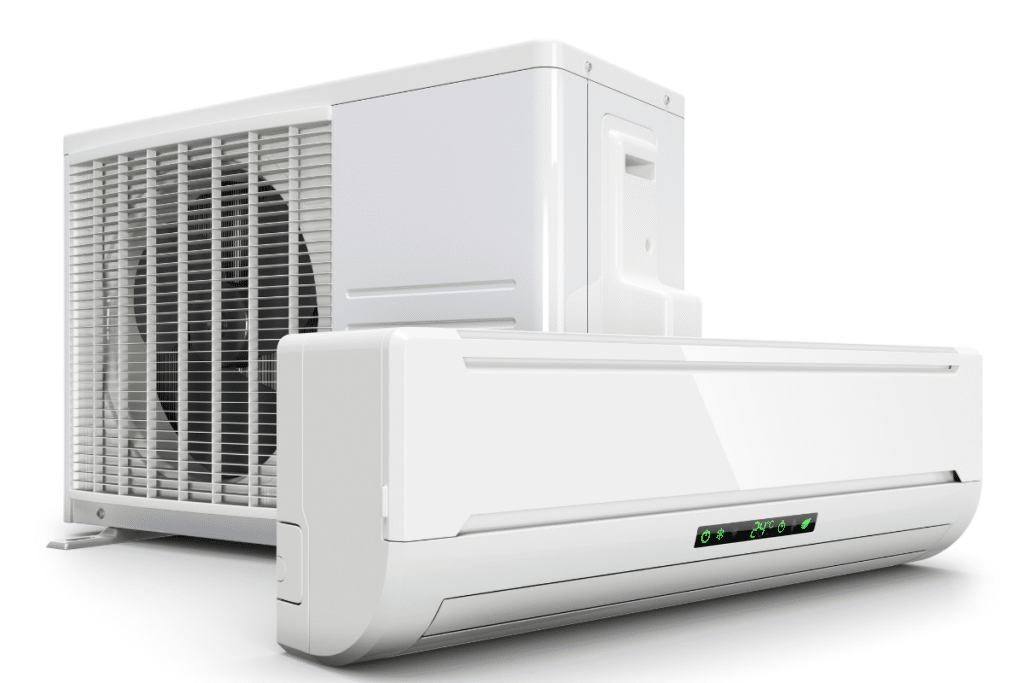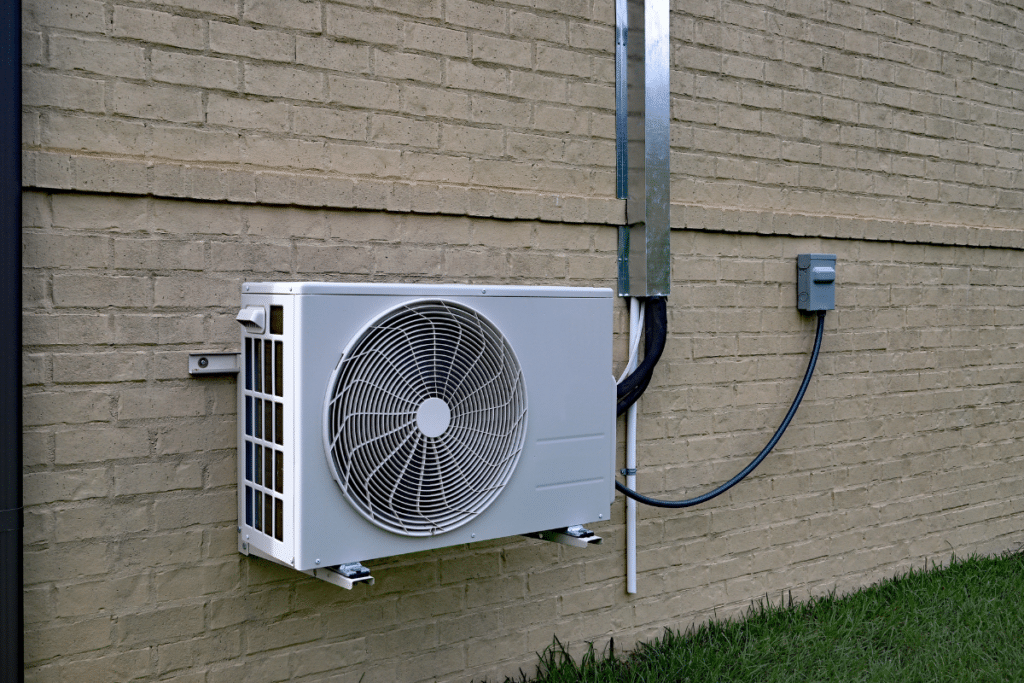Disadvantages of Mini-Split Systems

Mini-split systems have become popular among homeowners and businesses looking for an efficient means of cooling and heating their spaces. Like anything, there can be some drawbacks associated with them. Although there are some disadvantages to mini-split systems, the pros outweigh the cons, and they are a great choice for many of our customers in the East Peoria and surrounding areas. We will explore some of those pros and cons in this article so you can make the best choice when it comes to expanding on or updating your HVAC system.
A mini-split system is a type of air conditioning system. It is a ductless HVAC (Heating, Ventilation, and Air Conditioning) system that uses an outdoor compressor unit and one or more indoor units to cool and heat a room or area.
Unlike traditional central air conditioning systems, mini-split systems do not require ductwork, making them a more flexible and cost-effective option for residential and commercial applications. This can be a great advantage when you want to avoid adding more ductwork to your home. And, adding a mini split is a useful option when you need heating and cooling in an addition, like a sun room, to your home.

Here are the disadvantages of the mini-split system:
Mini-Split System’s Initial Cost
Mini split systems’ main disadvantage lies in their relatively expensive initial cost compared to other air conditioning systems, with installation typically costing anywhere between $3,000 and $10,000 depending on the size and complexity of installation. This cost could pose an obstacle for homeowners on tight budgets when considering installing a mini-split system.
Mini-Split System Require a Complicated Installation
A mini-split system has an intricate installation process. It involves attaching indoor unit, outdoor unit, and refrigerant lines – which may take as much as eight hours, depending on their size and complexity – for proper functioning. Installing them may prove challenging to those who need experience with HVAC systems. One question to ask your HVAC company is how many mini split systems have they installed. This will help you determine if you need to look for an HVAC company who is familiar and proficient at installing and maintaining mini-split systems.
Mini-Split System Require High Maintenance Cost
The mini-split system requires ongoing maintenance for optimal functioning, including cleaning the air filters and refrigerant levels to inspecting their electrical components. Homeowners should consider these costs when installing one of this mini-split systems in their homes.
Mini-Split System is not Well Suited for Large Spaces
Due to their limited heating and cooling systems’ capacities, a mini-split system may not be suitable for larger areas. Their capacity for cooling or heating one room at a time means multiple mini-split systems may need to be installed to achieve desired temperatures in larger rooms.
Compatibility with Existing HVAC Systems
The mini-split system may not be compatible with your current HVAC system. If you have a traditional HVAC system, upgrades may be necessary before installing a mini-split system – an expense that only adds to its high installation cost.
Noise Level
When running, a mini-split system can become quite loud. This may be an issue in areas with high levels of noise pollution, such as dense urban settings. For this reason, environmental concerns associated with mini-split systems must be considered before purchasing one at home.

Environmental Impact of Mini Split Systems
Mini-split systems may be energy-efficient, yet they still affect the environment.
Energy Efficiency
Mini-split systems are designed to be energy efficient. They use less electricity than traditional HVAC systems, saving on costs while contributing less greenhouse gas emissions. Despite being energy efficient, mini-split systems still consume electricity, adding to global greenhouse emissions.
Use of Refrigerants
Mini-split systems utilize refrigerants, which may adversely impact the environment. Refrigerants are greenhouse gases that contribute to global warming; refrigerant leakage from mini-split systems could result in the depletion of the ozone layer.
Carbon Footprint
Both production and installation of mini-split systems contribute to their carbon footprint, as the manufacturing process requires energy consumption, while installation can also use substantial energy resources. Homeowners should take note of the carbon footprint when considering whether to install these devices.

Health Risks Associated with Mini-Split Systems
Mini-split systems may present potential health hazards as well.
Mini Split Systems Can Affect Air Quality
Mini-split systems can accumulate dust and debris that compromises indoor air quality. If filters aren’t regularly cleaned out, allergens and pollutants may circulate throughout your space and reduce indoor air quality considerably.
Humidity Control
Mini split systems do not come equipped with the ability to manage humidity levels in your space. An external dehumidifier or humidifier might be required for optimal conditions if they become excessive or inadequate.
Noise Pollution
Noise pollution from mini-split systems can reduce the quality of life for occupants by contributing to stress, fatigue, and sleep disturbance. Homeowners should consider the noise level of mini-split systems when installing them in their homes.

Alternatives to Mini Split Systems
If mini-split systems don’t suit your space, other cooling systems should be considered.
Central HVAC Systems
Central HVAC systems are traditional cooling systems designed to efficiently cool or heat an entire building, using energy-efficient techniques and controlled by thermostats. While energy-efficient, these systems can be expensive to install; additionally, they often require complex ductwork installations, which may present challenges when retrofitted into older structures.
Window Units
Window units offer an affordable cooling option that is suitable for most windows. Designed to cool one room at a time and then removed and stored during off-season periods, window units may provide ample cooling but need to be more energy-efficient and quiet compared to alternative cooling solutions.
Portable Air Conditioners
Portable air conditioners provide an energy-efficient cooling solution, easily portable from room to room and controlled via remote. While energy-efficient, portable ACs may cause noise pollution; for hot air to escape properly, they require access to either a window or vent to exhaust.
Conclusion
Mini split systems offer homeowners and businesses a convenient yet costly cooling and heating option. Still, they can bring drawbacks such as high initial costs, complicated installation, high maintenance costs, limited cooling and heating capacity, compatibility issues with existing HVAC systems, and noise pollution.
They may also pose environmental and health risks, so homeowners must carefully consider all factors associated with installing such a system. Alternatives like central HVAC, window units, or portable air conditioners may provide better options in specific spaces.
Call AirAce Heating and Cooling for any HVAC concerns!

I have three mini splits an you cannot hear them run also I put them in myself an only paid 434.00 a piece an put them in in less than 3 hours a piece. my livingroom is 900 square ft an a 12,000 easily cools an heats it